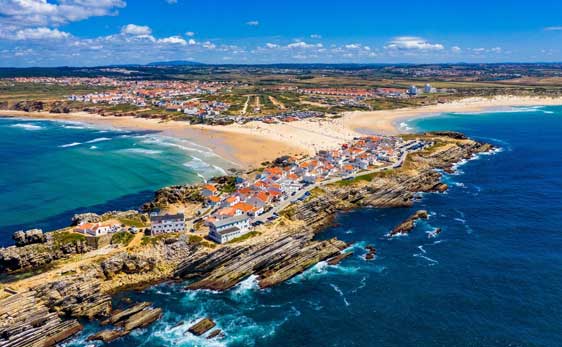The Silver Coast – Coastal Havens, Medieval Wonders, and Rustic Charm
By Terry Coles
Ever dream of sipping wine on your balcony with a view of the Atlantic Ocean in the distance but thought you could never afford it? Or perhaps living in the shadow of a medieval castle is more to your liking? From rolling hills of vegetation to acres of orchards and vineyards, cathedrals, castles, and alluring legends galore make up the history, mystery, and splendor of the Silver Coast.
Nestled along the western side of the country—between Porto and Lisbon—this 93-mile stretch of rugged coastline extends inland to include traditional rural villages packed with Portuguese charm and affordable living.
The Costa da Prata, as it’s called by the locals, begins near the canal city of Aveiro that meets up with the coast at Figueira da Foz. As the name suggests, figueira, is a fig tree that once stood at the mouth, or foz of the Mondego River. According to legend the town was named after a fig tree that fisherman once used to tie up their boats. Both Aveiro and Figueira are two of the tourist hubs along the Silver Coast—and for good reason. Colorful boats cruise the canals of Aveiro as they have for centuries. Once they used to carry seaweed, today they transport tourists past art nouveau homes along the bustling waterfront.
Further south is the fishing village of Nazaré where fisherman head out to sea in small boats just as they have for centuries. Behemoth waves entice daredevil surfers who embrace the challenge while others come to chill on the beaches. Summertime brings sunbathers but fall is when waves are at their highest, so tourists and locals alike come to watch.
Other seaside sanctuaries include São Martinho do Porto, with its scallop-shaped bay and calm waters and Salir do Porto with its colossal, captivating sand dunes to bring out the kid in everyone.
Foz do Arelho on the outskirts of Caldas da Rainha offers a two-for-one beach experience. One side features a tranquil lagoon—the perfect spot for children—while the other side opens to the sea but without large currents.
The walled medieval city of Óbidos is a short drive from the coast and a nice way to spend an afternoon. Continue south to Torres Vedras which hosts one of the largest Carnival celebrations in Portugal every year.
From stunning coastline, quaint cobbled villages, welcoming locals, and sizeable expat communities, the Silver Coast has much to offer, and the reason why so many foreigners call it home.
Retire to the Silver Coast

With thousands of foreigners already living on the Silver Coast life here can be jam-packed or laid-back and easy-going. Expat groups organize dinners, dances, and socials or gather to play board games, go bowling, hiking, biking, or horseback riding. Others enjoy bodyboarding or surfing, playing golf, or volunteering at local animal shelters and book clubs. Ladies’ groups meet for coffee and to socialize, while friends gather at local cafes to sip wine and people watch as the hours pass by. Fitness buffs will delight in the local gyms that offer classes in spinning, kickboxing, Pilates, yoga, Zumba, and more. Many organize beach-side bootcamps or group classes held at local parks too.
Portugal rates number twelve in the world for top-notch, affordable healthcare, and both private and public hospitals and clinics can be found almost everywhere on the Silver Coast. Shopping is abundant here with large shopping malls, local’s farmer’s markets, and small mom-and-pop stores too.
Lifestyle on the Silver Coast

Life on the Silver Coast is as slow moving as the windmills that dot the green hills in the distance. Old-time farmers roll by on tractors often carrying their wives on the back. White vans cruise through small villages selling freshly baked breads, pastries or fish caught earlier that morning. Locals greet each other with double-cheeked kisses and hand over bushels of home-grown fruits and vegetables from their garden. Corner cafes are filled with silver-haired gents in berets who hobbled in from nearby homes with canes.
The Portuguese people are wonderfully simpatico, or nice, and always offer a bom dia or smile to all those they see. Walk into any clinic, government office, elevator, or restaurant, and everyone is greeted with a smile and a hello.
Lively farmer’s markets in cities and villages offer colorful palates of produce, fish, baked goods, local honey, and handicrafts. Tiny shops sell assortments of ceramics still produced locally—an art form that is even taught at nearby schools.
Situated in the center of Portugal, the Silver Coast is one of the last affordable destinations in Europe that boasts all of the modern amenities. Buses and trains offer easy access to Lisbon airport and other larger cities throughout the country.
But with so much history, culture, and beauty purchasing a car is recommended to get around and enjoy all the splendor that the Silver Coast has to offer.

Get Your Free Portugal Report Here:
Romance, culture and adventure awaits in Portugal. Learn more about Portugal and other European countries in our daily postcard e-letter. Simply enter your email address below and we'll send you a FREE REPORT - Explore the Old World in Laidback Portugal.
This special guide covers real estate, retirement and more in Portugal and is yours free when you sign up for our IL postcards below.
Cost of Living on the Silver Coast

Buying a detached house with a pool close to area beaches in the Algarve will set you back a million dollars or more, but on the Silver Coast, this is not the case. In the seaside towns of Foz do Arelho or Nadadouro, homes with private pools not far from the coast can be found for $300,000 and up. Drive inland just ten minutes to Caldas da Rainha where massive, freestanding homes with gardens can be found for even less. Those who want something smaller can pick up deals on two-bedroom, city center apartments starting at $100,000.
The following cost of living is for a couple living with a car in the center of Caldas da Rainha. Just outside the city center private homes often rent apartments for much less.
| Item | Cost $ |
| Rent – two-bedroom, furnished, city center apartment | $700 |
| Utilities – Electric, heat, water, trash | $150 |
| Internet – cell phones for two | $65 |
| Health Insurance – (increases with age and health condition) | $150 |
| Transportation | $200 |
| Groceries | $500 |
| Gym membership | $65 |
| Entertainment – dining out, etc…. | $200 |
| Miscellaneous | $170 |
| Total: | $2200 |
The cost of living varies greatly depending on one’s lifestyle. Dining out frequently and traveling will add to the budget. Residents of Portugal have access to the low-cost public healthcare system but to apply for a long-stay residency visa, foreigners must show proof of private health insurance. Most expats prefer to keep private health because it is so affordable and allows access to English-speaking doctors of their choice and no wait times to have procedures.
Three Must-See Silver Coast Towns
1. Caldas da Rainha – The Baths of the Queen
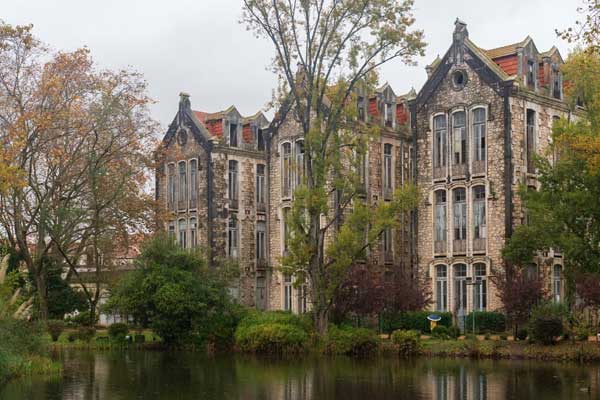
During the 15th century Queen Leonor was passing through the area when she spotted some pheasants bathing along the roadside in some murky liquid. Curious she questioned their strange habits and soon learned of the thermal water’s healing powers. Impressed, she ordered a hospital to be built around the thermal spring and that hospital has been serving patients ever since.
The mid-sized city of 51,000 is located just one hour north of Lisbon, the country’s capital city. The cobbled downtown comes alive daily with a daily farmer’s market packed with luscious produce, baked goods, nuts, dried fruits, and more. Nearby a daily fish market is where locals head to find the freshest catch of the day. Every Monday a massive flea market sells just about everything. From nuts to bolts, clothing, hardware, household items, and even live animals can be found here all at bargain prices.
Dom Carlos Park is the perfect spot for family outings around the duck pond where tiny boats can be rented for fun. Nearby the spectacular façade of the original thermal hospital stands proud against a modern museum, restaurant, tennis courts, and playground. Cross the street to La Vie, a multi-level modern shopping complex with a cinema, large food court, and plenty of shops.
Caldas offers both a public and private hospital, several dental and medical clinics, a bowling alley, sports complex, municipal pool, badminton club, gyms, large grocery stores, and cobbled oldtown.
Coastal gems like Nadadouro and Foz do Arelho are close by and the perfect way to cool off in the summer. Beachfront bars and restaurants boast nightly entertainment to rock the night away with friends.
Just a short drive from Caldas there are many beautiful towns to visit. The walled medieval city of Óbidos is just a ten-minute drive from the city center. Stroll along the narrow lanes, stop to sample ginginha, a local sour-cherry liquor served in edible chocolate cups, or stop for lunch at one of many restaurants.
The town of Alcobaça with its magnificent 12th-century monastery hides within its walls the love story of Inês de Castro and Dom Pedro, star-crossed lovers forbidden to be together by the king. Marvel at the architecture of the monastery from the tiled plaza that surrounds it while sipping a cappuccino and indulging in a pastel de nata, the famous Portuguese cream pies that are so addictive.
2. Aveiro – Canals, Color, and Coastline

At the northern end of the Silver Coast is the lively city of Aveiro. Known for its canals filled with colorful boats called moliceiros that were originally used to harvest seaweed, the city is now a tourist hub. Art nouveau homes line the waterfront, buskers perform to entertain the crowds, and locals rub elbows at the city center shopping mall. Just a short drive from the city is Costa Nova, famous for its candy-striped houses and golden sandy beaches. These once tiny fishing cottages are today new builds that reflect the sunshine off their whimsical facades.
Since so many tourists visit Aveiro, English speakers are easy to find—a plus for easing into expat life here. Your medical needs are well covered as well with Hospital da Luz, accredited by the well-known Joint Commission International, who awards this prestigious stamp to only the best.
With a population of 80,000, Aveiro is a must to visit but could be a place to settle into life as an expat too.
3. Nazaré – Colossal Waves and Fishing People
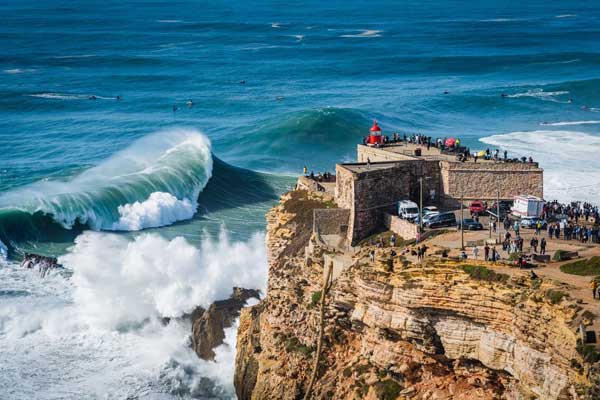
One of the most popular coastal towns along the Silver Coast is Nazaré. Tourists flock to the area to witness daredevil surfers tackle some of the largest waves in the world—the largest recorded was in 2020 and reached 101.4 feet. But step away from the coast and it’s the fishing people that come to light in this once sleepy fishing village. For centuries fisherman wake before dawn and head out to sea in tiny boats. Their wives stay behind and wait for them on shore. Dressed in seven layers of colorful skirts that extend down to the knee, the skirts can be pulled up over their shoulders to keep warm. Wool knee-socks protect their legs, while head scarfs are wrapped tightly around their long hair, often braided to the sides.
Be sure to visit o sitio, the old village perched on top of a cliff. The Sanctuary of Our Lady of Nazaré is decorated inside with impressive blue and white azulejos (Portuguese tiles). Outside the fishing wives—or Nazarenas—sell handicrafts to help supplement the family income. Afterward stroll the narrow lanes where fish hang, drying on clotheslines next to family’s laundry, a time-honored tradition.
Featured Image Copyright: ©iStock.com/DaLiu
How to Spend Seven Days on Portugal’s Silver Coast
By Terry Coles

Medieval walled villages and castles that whisper legends of lore, a rugged coastline weathered by colossal waves. Historic shrines, or so they say, where miracles once took place. Lush, green pastures, where life moves slowly and wine is tasty and cheap. An ancient thermal hospital put one town on the map, and museums, churches, cobbled lanes, and food keep tourists returning.
Portugal’s Costa da Prata, or Silver Coast, isn’t inundated with tourists yet has so much to offer. And it’s still one of the more affordable parts of the country. Here’s a guide on how to spend seven magical days along Portugal’s magical Silver Coast.

Night: 1, 2, and 3: Caldas da Rainha

Fly into Lisbon, the country’s capital city, and rent a car, the best way to maximize your time. Hit the road and drive one hour north, settling in for the night in the mid-sized city of Caldas da Rainha.
Drop off your luggage at the SANA Silver Coast Hotel in the heart of the city and head out on foot to explore. Across the street from the hotel lies Parque Dom Carlos I, a peaceful green haven boasting a pond filled with paddle boats, a museum, and restaurant. Across from the park is a multi-level, modern shopping center.
Just a short walk away is the cobbled old town filled with local eateries and cultural wonders. The name Caldas da Rainha literally means, “baths of the queen,” since the city was constructed around a thermal hospital, still in existence today. Inside the hospital is a small museum, and next door is a ceramics museum housed inside an old palace. Pop into the church nearby to admire the traditional blue and white tiles that adorn the walls.
Every morning the Praça da Fruta in the center of the old town comes alive with fresh produce, fish, meats, breads, and more. If you happen to be there on Monday morning, a flea market just up the hill offers most everything from soup to nuts.
Stroll around the city that has long been famed for ceramics, still produced locally at the school and sold in many of the tiny shops. When hunger strikes, stop at one of many restaurants before returning to the hotel for the night.
Day 2: Bombarral

For an unexpected treat, drive 20-minutes south to Bombarral and visit the largest Asian Buddha Garden in all of Europe. Spread over 87 acres, Bacalhôa Buddha Eden is a delightful garden of statues, ponds, lakes, and eateries where you can spend an entire relaxing day or less if desired.
Created to protest the destruction of the Buddhas of Bamyan, a city in Afghanistan, the garden developed into a peaceful retreat for those passing through the area. Jump aboard the train for a scenic ride through the grounds to rest your weary feet before stopping for lunch at the buffet-style restaurant. The estate is also well known for producing wine and selling it by the bottle on the premises.
Day 3: Óbidos
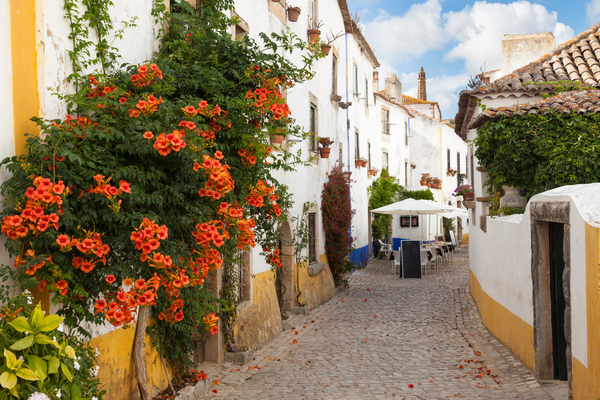
Just a 15-minute drive from Caldas da Rainha is the walled medieval town of Óbidos. Stroll the narrow lanes, sample a cup of ginja, a sour cherry-flavored liquor served in an edible chocolate cup, and browse the tourist shops. Head uphill to admire the well-preserved castle and climb its walls for a stunning view overlooking the area. Óbidos hosts many festivals throughout the year, including a medieval fair, chocolate festival, and holiday village.
The narrow-cobbled lanes in Óbidos are the ideal place to sit and people watch, have a bite to eat, and sample some of what Portugal is known for: food and wine.
You could return to Caldas da Rainha for the night, but another fun option is to spend the night at Pousada Castelo Óbidos. Originally a castle, it was transformed into a boutique hotel where you’ll be treated like royalty.
Night 4: Nazaré – One Night
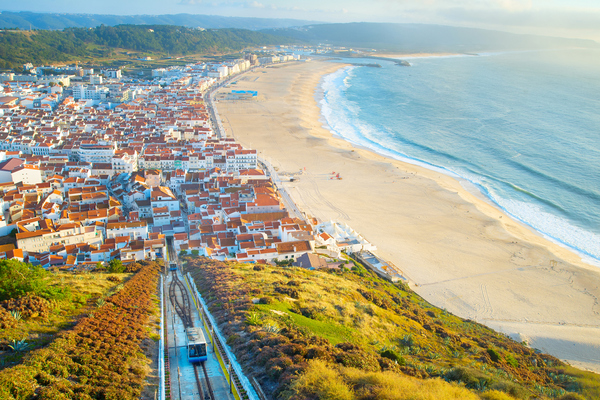
Thrill-seekers flock the surfing mecca of Nazaré to challenge the gargantuan waves. Just 30-minutes from Caldas da Raingan, this traditional fishing village is steeped in history. Be sure to look for the phishing wives, women whose husbands still head out to sea every morning as their livelihood. The women adorn themselves in seven-layered, multi-colored skirts, long enough to be pulled over their shoulders on cold winter days, with woolen knee socks, hats, and sweaters.
At the city’s highest point, called O Sitio, sits an imposing Marian shrine, the Sanctuary of Our Lady of Nazaré. Inner corridors of the sacristy offer a splendid surprise of stunning blue and white tiles sprawling along the walls and ceiling.
Stop for lunch at one of the many seafood eateries where you’ll find the fresh catch of the day, or sample a traditional fish stew called cataplana. After lunch, stroll around the village or relax on the beach for some fun in the sun.
The following morning head out to the nearby city of Alcobaça to see the famed Monastery or Royal Abbey of Santa Maria, founded by the Order of Cistercians in 1153. After exploring the church, pull up a chair at a café nearby for a glass of Portuguese wine or coffee and people-watch. Meander around the city center before heading out to the next location, Batalha.
As the name suggests, Batalha was named after the bloody Battle of Aljubarrota in 1385. The town is known for its jaw-dropping monastery, which shouldn’t be missed. Nearby is a museum along with reenactments of the famed battle, if you can fit it into your schedule.
Since Nazaré thrives on tourism, there’s no shortage of hotels to fit every budget, many with ocean views, swimming pools, free breakfast, and WiFi.
Night 5: Tomar – One Night

Leave Nazaré early and head out for the one-hour drive to Tomar, stopping along the way to visit the famed religious site of Fátima.
According to legend, it was here that the Virgin Mary appeared to three young shepherd children in 1917, revealing three secrets. On the thirteenth of October of the same year, some 70,000 believers were said to have witnessed the Miracle of the Sun, a phenomenon of the sun spinning in the sky for ten minutes before turning blue. A shrine was constructed on the site of the apparitions, and today pilgrims come from around the world, often on their knees, to pray and hope for a miracle. Fátima has become one of the world’s most important religious destinations, so it surely should be worth a few hours of your time.
Nearby you can visit the Fátima Museum of Wax, which tells the apparitions’ story using lifelike wax figures as a fun way to recreate history. Those who wish to know more can book a walking tour to see the village of Aljustrel, where the children lived, their homes, and other spots where apparitions occurred.
There isn’t much in the way of restaurants in Fátima, so it may be best to hop into your rental car and head out and eat in Tomar, your stop for the night.
Tomar once served as the headquarters for the Knights Templar, a religious military order that helped free Portugal from the Moors in the 12th and 13th centuries. Renamed the Order of Christ by King Dinis, he awarded the knights a castle complex to protect them, a majestic spot that put the town of Tomar on the map.
The Convent of Christ sits high on a hill overlooking the town of Tomar and is the town’s main attraction. Book a tour with a tuk-tuk that can easily be found in the town center to show you around and drop you off at the convent.
Construction of the convent began in 1162 and continued into the 1500s. The unique circular church, the Charola is where the knights could attend mass on horseback, a design inspired by the churches in Jerusalem. Spend an hour or two marveling at the construction and immense size of the famous complex before heading back into the town.
Stroll along the cobbled streets and admire the ornate homes where flowers dangle over the iron railings on the balconies. A black and white tiled plaza is complemented by a few churches, shops, and restaurants.
Not far from the town center of Tomar is The Castle of Almourol, a medieval castle that sits atop an inlet in the middle of the Tagus River. It once served as an important stronghold that helped the knights protect the area from invaders.
Enjoy dinner, wine, and dessert in town before heading to your hotel for the night.
Night 6: Aveiro
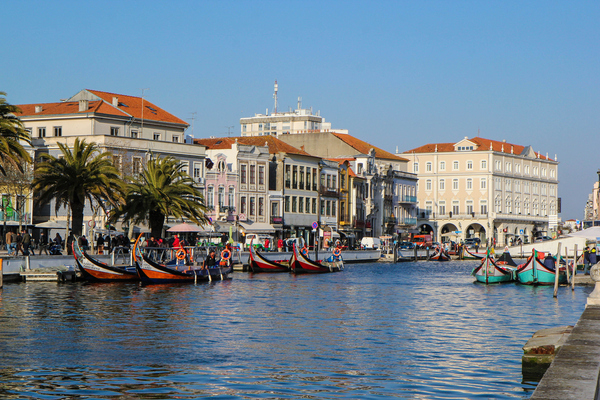
Pack up and leave your hotel early for another long day of exploring the Silver Coast, stopping for a few nights in the lively city of Aveiro.
Often called the Venice of Portugal, life in the quaint city of Aveiro happens on the canals. Narrow boats called moliceiros are colorfully decorated with painted graphics, florals, and scenes of yesteryear. Once used to harvest seaweed, today the boats transport tourists past art nouveau homes, cafes packed with tourists, shops, and restaurants.
Buy tickets at one of several stands along the canal front for the must-do boat ride along the canal, hosted by an entertaining guide. Nearby, a large shopping mall boasts designer brand names for the retail enthusiast or meander along the streets admiring the elaborately decorated homes.
Stop for coffee at one of the cafes and sample a well-known sweet treat called ovos moles, a wafer-like shell that hides a soft, sweetened egg filling inside.
Hop back into your car for a short drive to Costa Nova, famed for its candy-striped homes that are easy to spot. Used initially as fishing shacks, today, the homes appear to be elegant and modern, but are still charming. The beaches of Costa Nova are covered with supple, golden sand and massive dunes, perfect for children of all ages.
Option is to spend the remainder of the day on the beach relaxing and spend the night in Aveiro or visit another new town and continue to Coimbra.
If your visit happens to be in summer, a stop in the tiny town of Águeda should be on your agenda. Every summer, the town livens up with the Sky Umbrella Project. Hundreds of colorful umbrellas are suspended from the wires over the streets, protecting it from the hot sun. Local artists decorate trash bins, staircases, and walls giving the town a funky, colorful vibe, while sidewalks are covered with green carpeting to add to the fun.
Back into the car, keep heading north to the university town of Coimbra for the night.
Night 7: Coimbra

Wake early and head out since there is much to see in this hilly university town. The first stop is the University of Coimbra, the oldest in Portugal that sits high on a hill overlooking the city. After you’ve caught your breath from walking uphill, you can climb the 180 steps of the university’s 16th-century tower, if you dare, for a birds-eye view of the city.
Be sure to visit the spectacular Joanina library on the university grounds, where 250,000 books have been preserved from the 1500s. Some subjects included in the book are medicine, law, history, and science. Interesting to note is that the books are kept meticulously preserved by a colony of bats that serve to eat insects that would otherwise damage the books. The bats only come out at night after the library is closed, so there is nothing to fear.
The university’s 16th-century chapel can be visited and features different styles of architecture, including baroque, manueline, and neoclassical. and is decorated with traditional Portuguese tiles.
Other points of interest in Coimbra include the Monastery of Santa Cruz, the final resting place of several Portuguese kings who were laid to rest in elaborate tombs displayed on either side of the altar. The organ in the church is covered with Japanese art and was crafted with 4000 pipes making it so difficult to play that only four people ever mastered it.
The Old Cathedral of Coimbra was built in 1162 in Romanesque style, unusual since the country was still battling the Moors. Because of the battle the church looks more like a fortress than a church, with characteristic narrow windows and battlements.
Once part of the Jesuit college, the New Cathedral started life as a temple in 1598 but transformed into a cathedral in 1772. Although not quite as old as the first cathedral, it’s still worth a peek.
The Monastery of Santa Clara-a-Velha, or old monastery, was founded in 1283 by a river that often flooded the building. A new monastery was constructed in 1677, about a 15-minute walk from the old building. Explore the Gothic ruins of the old relic and browse through the museum and new monastery, marveling at the architecture and details.
The botanical gardens of the University of Coimbra are a welcomed respite for weary travelers. Enter the gardens through the 16th-century gate next to the aqueduct, rest by the fountain, and breathe in the aromas that fill the air. With an area covering 32 acres, the spectacular gardens feature plants, trees, shrubs, and flowers from across the globe. Built in 1772 and once considered the best botanical garden in the world, famed Portuguese sculptors have added their own flair with statues and fountains to give it the perfect ambiance.
Enjoy an early dinner before retiring for the night in your hotel, as you prepare for your long flight home the next day. The drive from Coimbra back to Lisbon airport is about two hours, so allow plenty of time to return your rental car, check in for your flight, and reminisce about your fantastic week exploring Portugal’s Silver Coast.

